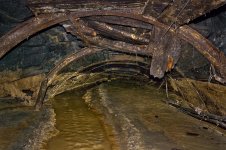I'm afraid I have no knowledge of the hydrology of this area, or the intricacies of the mine drainage, but as a general rule, blocking or slowing flow upstream, reduces peak flow and therefore flooding downstream.
All modern drainage systems are specifically designed to hold back peak flows through the incorporation of permeable surfaces to slow run-off to the system, attenuation ponds, tanks, or oversized pipes, to hold back peak flows and release them slowly after the storm event.
An abandoned mine (assumed to be upstream) is likely to hold a huge volume of water if the adit is partially blocked, forming a natural flow control. Water levels will increase during a storm event as the water won't get out as fast as it comes in. This will then drain down over time, at a lower flow rate.
Clearing the adit will simply allow all the water from a storm event to escape straight away, at a much higher flow rate, increasing the problem.
Clearing blockages through the village, or further downstream will allow the water that is coming out to escape quicker and reduce flooding in that area, but it will in turn increase the flow rate, and hence flood risk, further downstream.




